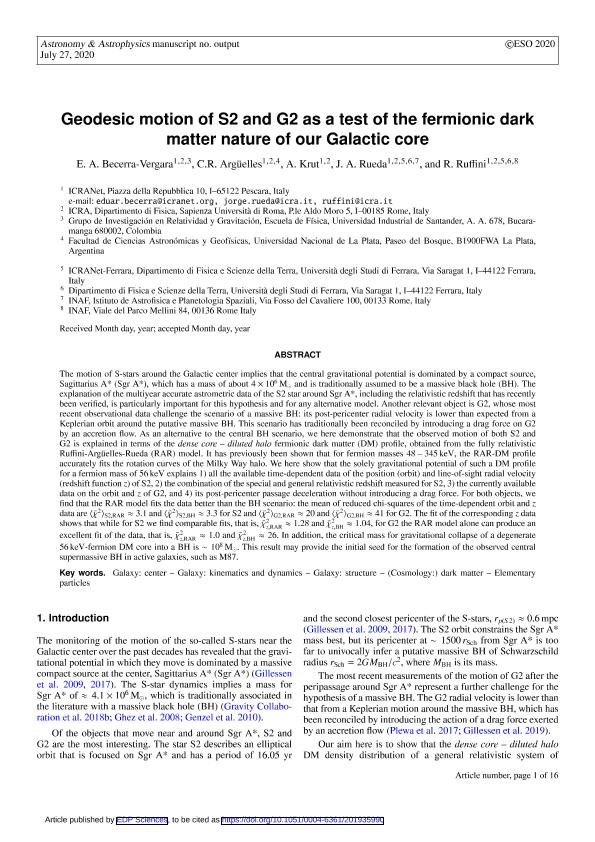Artículo
Geodesic motion of S2 and G2 as a test of the fermionic dark matter nature of our Galactic core
Fecha de publicación:
04/09/2020
Editorial:
EDP Sciences
Revista:
Astronomy and Astrophysics
ISSN:
0004-6361
e-ISSN:
1432-0746
Idioma:
Inglés
Tipo de recurso:
Artículo publicado
Clasificación temática:
Resumen
The motion of S-stars around the Galactic center implies that the central gravitational potential is dominated by a compact source, Sagittarius A∗ (Sgr A∗), which has a mass of about 4 × 106 M⊠and is traditionally assumed to be a massive black hole (BH). The explanation of the multiyear accurate astrometric data of the S2 star around Sgr A∗, including the relativistic redshift that has recently been verified, is particularly important for this hypothesis and for any alternative model. Another relevant object is G2, whose most recent observational data challenge the scenario of a massive BH: its post-pericenter radial velocity is lower than expected from a Keplerian orbit around the putative massive BH. This scenario has traditionally been reconciled by introducing a drag force on G2 by an accretion flow. As an alternative to the central BH scenario, we here demonstrate that the observed motion of both S2 and G2 is explained in terms of the dense core-diluted halo fermionic dark matter (DM) profile, obtained from the fully relativistic Ruffini-Argüelles-Rueda (RAR) model. It has previously been shown that for fermion masses 48-345 keV, the RAR-DM profile accurately fits the rotation curves of the Milky Way halo. We here show that the solely gravitational potential of such a DM profile for a fermion mass of 56 keV explains (1) all the available time-dependent data of the position (orbit) and line-of-sight radial velocity (redshift function z) of S2, (2) the combination of the special and general relativistic redshift measured for S2, (3) the currently available data on the orbit and z of G2, and (4) its post-pericenter passage deceleration without introducing a drag force. For both objects, we find that the RAR model fits the data better than the BH scenario: The mean of reduced chi-squares of the time-dependent orbit and z data are â χ 2â.
Archivos asociados
Licencia
Identificadores
Colecciones
Articulos(CCT - LA PLATA)
Articulos de CTRO.CIENTIFICO TECNOL.CONICET - LA PLATA
Articulos de CTRO.CIENTIFICO TECNOL.CONICET - LA PLATA
Citación
Becerra Vergara, E. A.; Argüelles, Carlos Raúl; Krut, A.; Rueda, J. A.; Ruffini, Remo; Geodesic motion of S2 and G2 as a test of the fermionic dark matter nature of our Galactic core; EDP Sciences; Astronomy and Astrophysics; 641; 4-9-2020; 1-16
Compartir
Altmétricas




